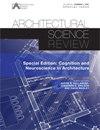采用表面模具进行热调制
IF 1.8
3区 艺术学
0 ARCHITECTURE
引用次数: 0
摘要
计算机数控机床作为一种数字化制造技术,可以产生各种纹理作为铣削表面。这些纹理的几何特性取决于设计者设置的各种参数。本文重点介绍了数控刀具、刀具路径和切削深度,以了解它们在(12.7 × 12.7)cm2的面板表面。3D Rhinoceros和其他插件用于研究由两个不同的CNC工具(球形和V形钻头)、两个工具路径(切入粗加工和平行)和各种工具跨步产生的纹理。模拟研究的重点是面板表面接收的太阳辐射和表面纹理投射的自阴影。结果表明,每种工具、工具路径和工具跨步对面板表面太阳能控制的影响不同。与平板相比,使用V型钻头可增加17%的辐射量,使用球形钻头可减少32%的辐射量。本文章由计算机程序翻译,如有差异,请以英文原文为准。
Employing surface tooling for thermal modulation
Computer Numerical Controlled (CNC) machines, as one of the digital fabrication technologies, can create various textures as milled surfaces. The geometrical properties of these textures depend on various parameters set by the designer. This paper focuses on CNC cutting tools, tool paths, and cut depth to understand their roles in generating different surface textures on a (12.7 × 12.7)cm2 panel surface. 3D Rhinoceros, and other plugins were used to study the texture created by two distinct CNC tools (ball and vee bits), two tool paths (plunge roughing and parallel), and various tool stepovers. The simulation studies focused on the solar radiation received by the panel surfaces and self-shadow cast by the surface texture. The results showed that each tool, tool path, and tool stepover had different effects on the panel surface solar control. Using vee-type bits increased the amount of radiation by 17% compared to the flat panel and using ball-type bits decreased it by 32%.
求助全文
通过发布文献求助,成功后即可免费获取论文全文。
去求助
来源期刊

Architectural Science Review
ARCHITECTURE-
CiteScore
4.80
自引率
8.70%
发文量
34
期刊介绍:
Founded at the University of Sydney in 1958 by Professor Henry Cowan to promote continued professional development, Architectural Science Review presents a balanced collection of papers on a wide range of topics. From its first issue over 50 years ago the journal documents the profession’s interest in environmental issues, covering topics such as thermal comfort, lighting, and sustainable architecture, contributing to this extensive field of knowledge by seeking papers from a broad geographical area. The journal is supported by an international editorial advisory board of the leading international academics and its reputation has increased globally with individual and institutional subscribers and contributors from around the world. As a result, Architectural Science Review continues to be recognised as not only one of the first, but the leading journal devoted to architectural science, technology and the built environment. Architectural Science Review publishes original research papers, shorter research notes, and abstracts of PhD dissertations and theses in all areas of architectural science including: -building science and technology -environmental sustainability -structures and materials -audio and acoustics -illumination -thermal systems -building physics -building services -building climatology -building economics -ergonomics -history and theory of architectural science -the social sciences of architecture
 求助内容:
求助内容: 应助结果提醒方式:
应助结果提醒方式:


